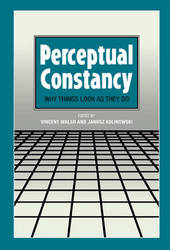
|
Perceptual Constancy: Why Things Look as They Do
Hardback
Main Details
| Title |
Perceptual Constancy: Why Things Look as They Do
|
| Authors and Contributors |
Edited by Vincent Walsh
|
|
Edited by Janusz Kulikowski
|
| Physical Properties |
| Format:Hardback | | Pages:560 | | Dimensions(mm): Height 229,Width 152 |
|
| ISBN/Barcode |
9780521460613
|
| Classifications | Dewey:152.14 |
|---|
| Audience | | Professional & Vocational | |
|---|
|
Publishing Details |
| Publisher |
Cambridge University Press
|
| Imprint |
Cambridge University Press
|
| Publication Date |
13 August 1998 |
| Publication Country |
United Kingdom
|
Description
Perceptual Constancy examines a group of long-standing problems in the field of perception and provides a review of the fundamentals of the problems and their solutions. Experts in several different fields--including computational vision, physiology, neuropsychology, psychophysics and comparative psychology--present their approaches to some of the fundamental problems of perception: How does the brain extract a stable world from an ever changing retinal input? How do we achieve color constancy despite changes in the wavelength content of daylight? How do we recognize objects from different viewpoints? And how do we know the sizes of those objects? The volume is divided into three sections. The first describes color constancy, the second examines size, shape and speed, and the third section is on perceptual inconstancies.
Reviews"This interesting...volume updates research on the nature of perceptual constancies and how they arise. ...this important work should become a core reference in this area. ...the primary audience for the book will be graduate students and researchers in experimental psychology. Recommended to libraries serving these readers." Choice "...this volume should be a valuable resource for both graduate students and researchers in visual perception. The book consists of 18 chapters that examine perceptual constancy from a variety of viewpoints. Developmental, comparative, psychophysical, psychological, and computational perspectives are represented in this collection." Journal of Mathematical Psychology
|